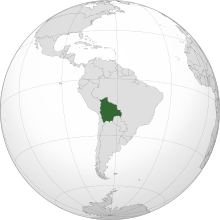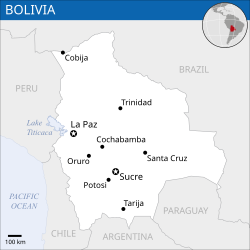
Back Боливиа Abkhazian Bolivia ACE Боливие ADY Bolivië Afrikaans Bolivien ALS ቦሊቪያ Amharic Bolivia AMI Bolivia AN Bolifia ANG बोलीविया ANP
Plurinational State of Bolivia | |
|---|---|
| Motto: "La Unión es la Fuerza" (Spanish) "Unity is Strength"[1] | |
| Anthem: "Himno Nacional de Bolivia" (Spanish) | |
| Dual flag Wiphala | |
 Location of Bolivia (dark green) in South America (grey) | |
 | |
| Capital | Sucre (constitutional and judicial) La Paz (executive and legislative) |
| Largest city | Santa Cruz 17°48′S 63°10′W / 17.800°S 63.167°W |
| Official languages[2] | |
| Ethnic groups (2009[3]) |
|
| Religion (2018)[4] | 88.9% Christianity —70.0% Roman Catholic —17.2% Protestant —1.7% Other Christian 9.3% No religion 1.2% Other religions 0.6% No answer |
| Demonym(s) | Bolivian |
| Government | Unitary presidential constitutional republic |
| Luis Arce | |
| David Choquehuanca | |
| Legislature | Plurinational Legislative Assembly |
| Chamber of Senators | |
| Chamber of Deputies | |
| Independence | |
• Recognized | 21 July 1847 |
• Admitted to the United Nations | 14 November 1945 |
• Current republic | 7 February 2009 |
| Area | |
• Total | 1,098,581 km2 (424,164 sq mi) (27th) |
• Water (%) | 1.29 |
| Population | |
• census estimate | |
• Density | 10.4/km2 (26.9/sq mi) (224th) |
| GDP (PPP) | 2019 estimate |
• Total | $89.018 billion[5] (88th) |
• Per capita | $7,790[5] (123rd) |
| GDP (nominal) | 2019 estimate |
• Total | $40.687 billion[5] (90th) |
• Per capita | $3,823[5] (117th) |
| Gini (2018) | medium |
| HDI (2019) | medium · 107th |
| Currency | Boliviano (BOB) |
| Time zone | UTC−4 (BOT) |
| Driving side | right |
| Calling code | +591 |
| ISO 3166 code | BO |
| Internet TLD | .bo |
Bolivia[a] /bəˈlɪviə/ (![]() listen), officially the Plurinational State of Bolivia,[b][8][9] is a country in South America. It is land locked by Brazil, Paraguay, Argentina, Peru, and Chile. Luis Alberto Arce Catacora became the president of Bolivia in November 2020.
The population of Bolivia is 8-9 million (2019).
listen), officially the Plurinational State of Bolivia,[b][8][9] is a country in South America. It is land locked by Brazil, Paraguay, Argentina, Peru, and Chile. Luis Alberto Arce Catacora became the president of Bolivia in November 2020.
The population of Bolivia is 8-9 million (2019).
Bolivia is named after Simón Bolívar. The main languages are Spanish and Quechua, but there are other languages too.
- ↑ "Moneda de 10 Centavos" [10 Cent Coins] (in Spanish). Central Bank of Bolivia. Archived from the original on 28 April 2007. Retrieved 28 January 2014.
- ↑ "Nueva Constitución Política Del Estado > PRIMERA PARTE > TÍTULO I > CAPÍTULO PRIMERO > Modelo De Estado: Ley de Bolivia". JUSTIA Bolivia (in European Spanish). Archived from the original on 25 February 2017. Retrieved 24 February 2017.
- ↑ "South America :: Bolivia". The World Factbook. Central Intelligence Agency. Archived from the original on 13 February 2011. Retrieved 25 March 2017.
{{cite web}}: More than one of|archivedate=and|archive-date=specified (help); More than one of|archiveurl=and|archive-url=specified (help) - ↑ Religion affiliation in Bolivia as of 2018. Based on Latinobarómetro. Survey period: 15 June to 2 August 2018, 1,200 respondents.
- ↑ 5.0 5.1 5.2 5.3 "Report for Selected Countries and Subjects". www.imf.org. Retrieved 29 August 2020.
- ↑ "GINI index (World Bank estimate) – Bolivia". World Bank. Archived from the original on 11 August 2018. Retrieved 22 March 2020.
- ↑ Human Development Report 2020 The Next Frontier: Human Development and the Anthropocene (PDF). United Nations Development Programme. 15 December 2020. pp. 343–346. ISBN 978-92-1-126442-5. Retrieved 16 December 2020.
- ↑ "Bolivia (Plurinational State of)". World Health Organization. 11 May 2010. Archived from the original on 6 October 2010. Retrieved 30 August 2010.
- ↑ "Bolivia (Plurinational State of)". UNdata. Archived from the original on 2 July 2010. Retrieved 30 August 2010.
<ref group=lower-alpha> tags or {{efn}} templates on this page, but the references will not show without a {{reflist|group=lower-alpha}} template or {{notelist}} template (see the help page).


